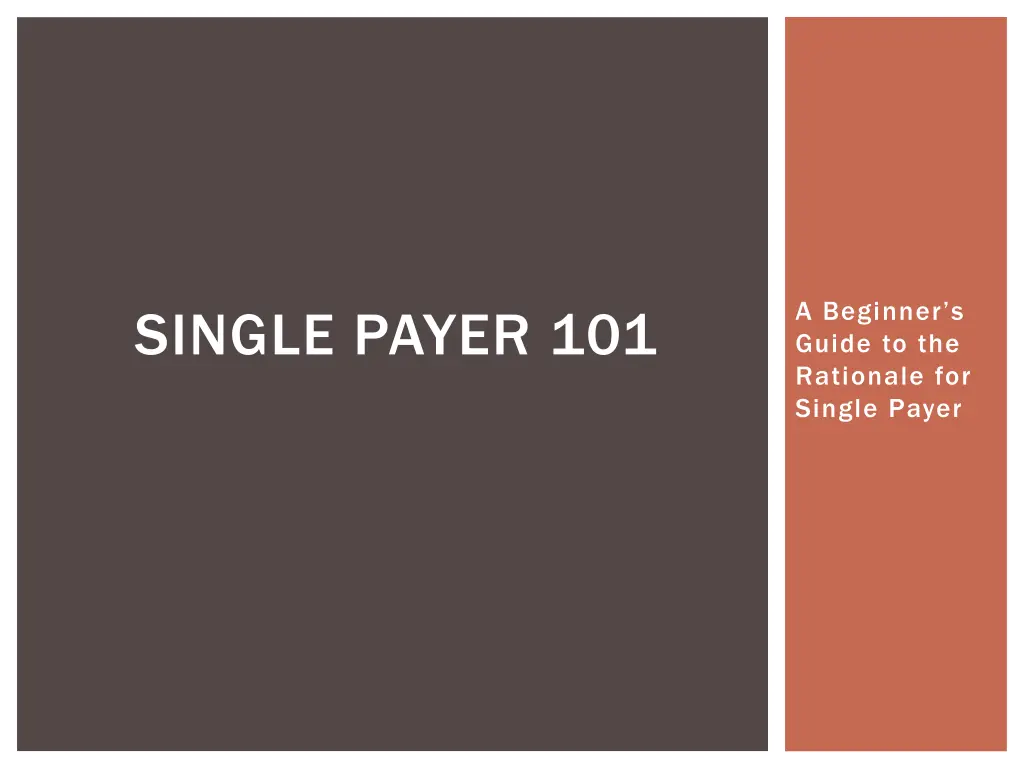
Understanding the Rationale for Single Payer Healthcare
Explore the key aspects of single-payer healthcare, debunking common misconceptions, discussing financing via private insurance, highlighting problems with for-profit interests and the uninsured, and examining trends in private insurance coverage vs. the uninsured population in the United States.
Download Presentation

Please find below an Image/Link to download the presentation.
The content on the website is provided AS IS for your information and personal use only. It may not be sold, licensed, or shared on other websites without obtaining consent from the author. If you encounter any issues during the download, it is possible that the publisher has removed the file from their server.
You are allowed to download the files provided on this website for personal or commercial use, subject to the condition that they are used lawfully. All files are the property of their respective owners.
The content on the website is provided AS IS for your information and personal use only. It may not be sold, licensed, or shared on other websites without obtaining consent from the author.
E N D
Presentation Transcript
A Beginners Guide to the Rationale for Single Payer SINGLE PAYER 101
What Single-Payer Is NOT: NOT a reimbursement strategy Can coexist with fee-for-service, capitation, DRGs, etc. NOT a health-care delivery scheme NOT government employment of/control over doctors (socialized medicine) NOT socialism Webster s Dictionary: any of various economic and political theories advocating collective or governmental ownership and administration of the means of production and distribution of goods NOT a magic bullet, but still very important
Problems: For-Profit Interests What does competition look like? Adverse Selection The Medical Loss Ratio Policy Recission Pre-Existing Conditions Experience Rating & Regressive Financing High Deductible Plans
Problems: The Uninsured & Underinsured Insurance & Employers 2011: >21% of people in working households uninsured1 Lack of Portability Fragmented Access & Lack of Choice Incomplete Coverage 2010: 33% of Americans forwent seeing a doctor or filling a prescription due to costs2 Financial Hardship Medical bills contribute to half of all bankruptcies3 Health Consequences 45,000 deaths annually are attributed to a lack of health insurance4 1. US Census Bureau, 2012 2. Schoen C, et al. How health insurance design affects access to care and costs, by income, in eleven countries. Health Affairs 2010; 29(12): 2323-34. 3. Himmelstein, DU. et al. Medical Bankruptcy in the United States, 2007: Results of a National Study. American Journal of Medicine 2009: 122: 741-46 4. Wilper, et al. Health Insurance and Mortality in US Adults. American Journal of Public Health 2009; 99(12).
More and More Uninsured Americans 50 Millions of Uninsured American 45 40 35 30 25 20 1976 1980 1985 1990 1995 2000 2005 2012 Source: Himmelstein, Woolhandler & Carrasquilo. Tabulation from CPS & NHIS data
Shrinking Private Insurance Percent with private coverage 80% 70% 60% 50% 1960 1970 1980 1990 2000 2012 Source: Himmelstein and Woolhandler Tabluations from CPS and HIAA data Note: Data are not adjusted for minor changes in survey methodology
Chronically Ill and Uninsured Condition % Uninsured # of Uninsured Diabetes 16.6% 1.4 million Elevated cholesterol 11.9% 4.0 million Hypertension 15.5% 5.9 million Asthma / COPD 19.3% 3.5 million Previous cancer 15.4% 1.1 million Cardiovascular disease 16.1% 1.3 million Any of the above 15.6% 11.4 million Source: Wilper et al. Annals of Internal Medicine. 2008;149:170
44,798 Adult Deaths Annually Due to Uninsurance State State Percent Uninsured Percent Uninsured Excess Deaths Excess Deaths California 23.9% 5,302 Texas 29.7% 4,675 Florida 26.0% 3,925 New York 17.5% 2,254 Georgia 23.6% 1,841 USA USA 15.3% 15.3% 44,798 44,798 Source: Wilper et al. Am J Public Health 2009. State tabulations by author
Problems: Waste Contract Negotiation & Bargaining Power Administrative Costs 31% of health care expenditures in the US vs. 16.7% in Canada1 Insurer Waste Eligibility Screening Underwriting Dividends and Salaries Managed Care Provider Waste Billing and Coding Approval and Appeals in Managed Care Lack of check on for-profit providers 1. Woolhander S, Campbell T, Himmelstein DU.Cost of health care administration in the United States and Canada. NEJM 2003;349(8): 768-775.
Growth of Physicians and Administrators 3000% 2500% Growth Since 1970 2000% 1500% 1000% 500% 0 1970 1980 1990 2000 2010 Physicians Administrators Data updated through 2013 Source: Bureau of Labor Statistics; NCHS; Himmelstein/Woolhandler analysis of CPS
Overall Administrative Costs $4,000 Dollars per capita, 2014 $3,000 $3,006 $2,000 $1,000 $787 $0 USA Canada Source: Woolhandler/Himmelstein/Campbell NEJM 2003;349:769 (updated 2013)
Insurance Overhead $700 $600 $606 Dollars per Capita $500 $400 $344 $300 $280 $258 $200 $226 $148 $100 $0 USA CAN HOL GER AUSL SWI Note: Data are for 2011 or most recent available Figures adjusted for Purchasing Power Parity Source: OECD, 2013
Key Features of Single Payer Covers everyone, from birth to death Comprehensive coverage, including payments to medical, dental, vision, and long-term care Administrative pricing and bulk purchasing by the non-profit governmental payer Progressive financing and subsidized access for the poor
Benefits of Single-Payer Non-Profit Patients getting care as the bottom line No need to exclude the sick Universal coverage True spreading of risk Community rating and progressive contributions Fully portable coverage Streamlined Administration More efficient billing and reimbursement Compatible with any reimbursement strategy
More Benefits of Single Payer More effective payer-provider negotiations More even distribution of power Balances delivery of care and cost savings Government accountability Democratic process decides amount of coverage/expenditures Transparency Patients as the stakeholders Facilitates further reforms Encourages change in reimbursement strategies Allows directing of dollars where they re needed most A coordinated way to pay for improvements in quality
What about the ACA/Obamacare? Subsidizes expansion of private insurance coverage Minimum essential benefits, but many exceptions/grandfathered plans About 30 million people will remain uninsured Medicaid expansion now optional Limits on MLRs Virtually no measures that will reduce costs Public option lost to political wrangling
Contacts Josh.Faucher@gmail.com www.PNHP.org PNHP s Annual Meeting Every Fall (end of October) SNaHP s New Student Summit Every Spring (April/May) Student Stipends Available






















